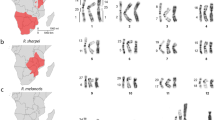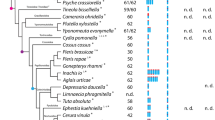Abstract
The fluorescence analysis carried out in Triturus alpestris alpestris and Triturus alpestris cyreni subspecies has revealed differences related to the content and distribution of AT-rich, GC-rich and non-fluorescent heterochromatic bands. These results provide new evidence on the chromosome differentiation undergone in their phylogenetic splitting.
Similar content being viewed by others
Article PDF
References
Arano, B, and Arntzen, J W. 1987. Genetic differentiation in the alpine newt Triturus alpestris. In van Gelder, J. J., Strijbosch, H. and Bergers, P. J. M. (eds) Proc Fourth Ord Gen Meet SEH, Nijmegen 1987, Faculty of Sciences Nijmegen Press, pp. 21–24.
Dubois, A, and Breuil, M. 1983. Decourverte de Triturus alpestris (Laurenti, 1768) en Calabre (Sud de l'Italie). Alytes, 2, 9–18.
Herrero, P, and Arano, B. 1986. Cytogenetic and morphological studies on Triturus alpestris cyreni. In Rocek, Z. (ed.) Studies in Herpetology, Charles University Press, pp. 114–117.
John, B. 1988. The biology of heterochromatin. In Verma, R. S. (ed.) Heterochromatin: Molecular and Structural Aspects, Cambridge University Press, pp. 1–147.
MacGregor, H C, and Sessions, S K. 1986. The biological significance of variation in satellite DNA and heterochromatin in newts of the genus Triturus: an evolutionary perspective. Phil Trans R Soc Lond, B312, 243–259.
Schmid, M. 1980. Chromosome banding in Amphibia. IV. Differentiation of GC and AT rich chromosome regions in Anura. Chromosoma, 77, 83–103.
Schmid, M, Olert, J, and Klett, C. 1979. Chromosome banding in Amphibia. III. Sex chromosomes in Triturus. Chromosoma, 71, 29–55.
Schweizer, D. 1976. Reverse fluorescent chromosome banding with chromomycin and DAPI. Chromosoma, 58, 307–324.
Schweizer, D. 1980. Simultaneous fluorescent staining of R-bands and specific heterochromatin regions DA-DAPI bands in human chromosomes. Cytogenet Cell Genet, 27, 190–193.
Schweizer, D. 1981. Counterstain enhanced chromosome banding. Hum Genet, 57, 1–14.
Schweizer, D, and Loidl, J. 1986. A model for heterochromatin disperson and the evolution of C-band patterns. Chromosome Today, 9, 61–74.
Sumner, A T. 1972. A simple technique for demonstrating centromeric heterochromatin. Exp Cell Res, 75, 304–306.
Thorn, R. 1968. Les Salamandres d'Europe, d'Asie et d'Africa du Nord Lechevalier, Paris.
Wolterstorff, W. 1932. Triturus alpestris subsp. cyreni eine neue Unterart des Bergmolches aus Nordwestspanien. Zool Anz, Leipzig, 97, 135.
Author information
Authors and Affiliations
Rights and permissions
About this article
Cite this article
Herrero, P., Bella, J. & Arano, B. Characterization of heterochromatic regions in two Triturus alpestris subspecies (Urodela: Salamandridae). Heredity 63, 119–123 (1989). https://doi.org/10.1038/hdy.1989.82
Received:
Issue date:
DOI: https://doi.org/10.1038/hdy.1989.82



